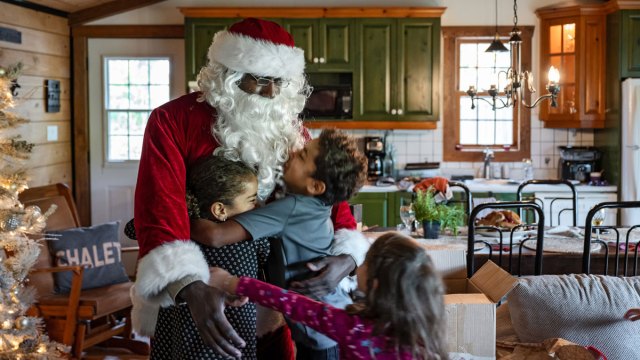When I was growing up in the ‘80s and ‘90s, Santa had a full, white, fluffy beard; a rounded stomach; and rosy cheeks. He was also always white. As a child, I didn’t think anything of it. But when I became a mom, the idea of what “classic Santa” should look like changed.
My husband and I always knew we would have children. But after a near-death experience and autoimmune diagnosis in my mid-20s, we decided that adoption was our best option. On a balmy November Saturday, we got the call that would change our lives. A birth mother had chosen us to adopt her baby—a Black girl. We were giddy; we furiously packed and traveled four hours to meet our new daughter.
Six weeks later, she would experience her first Christmas. It was during this holiday season that we noticed the serious lack of brown-skinned representation in décor, advertisements, books, cards, and more. Why was Santa always a white man? Yes, we know the history of Saint Nicholas, but the Santas we see today (and have seen for years) are representations—not the actual Santa. Why couldn’t he be Black like our daughter?
Santa is a symbol of generosity, joy, and hope. He is magical, jolly, and accepting. Because Santa embodies Christmas magic, why shouldn’t his exterior represent the diversity of the children he loves?
Once our second daughter came home, two years later, we finally managed to find a Black Santa at a local mall. However, he was only there every other Monday evening. I guess white Santa was either far more popular, or the mall was simply trying to show off its “diversity” without much investment. My then-two-year-old was thrilled to visit a Santa who, in her words, was “Black like me.”
Related: The Wildly Inappropriate Things People Ask Adoptive, Multiracial Families
Fast forward 14 years, and we have four children, all of whom are Black. We are so grateful that companies have scootched over and made room—a lot of room, in fact—for Black Santa. We can’t walk into a store without seeing multiple images of Black Santa—on greeting cards, on ornaments, on pre-made decorated sugar cookies. And yes, in person.
Honestly, we can’t get enough of him. We have Black Santa (and angel and nativity) décor all over our home. We buy every roll of Black Santa wrapping paper we can find—sharing the Black Santa joy with others. Our tree is covered in ornaments featuring people with brown skin and curly hair.
Some people have asked me—knowing our obsession—what the problem is with white Santa. The truth is, we don’t have a problem with him. What we do take issue with is when white Santa is the only option and is deemed the superior default.
Anyone who gets wound up over an alternative should ask themselves why they find a mystical being so threatening. What is it within them that so deeply rejects the notion that Santa can be Black—especially when he brings so many children the seasonal joy they yearn for?
Back at our house, Santa is unapologetically Black. He nibbles on cookies and sips milk before leaving a stack of gifts for my kids on Christmas Eve. He is a superhero or role model of sorts, making my kids’ holiday merry and bright. No matter what your kids look like, he can make their Christmas magical, too.











